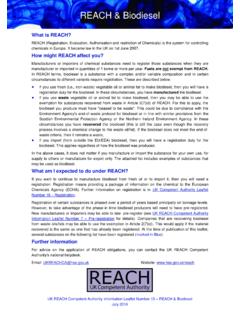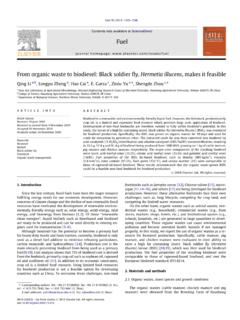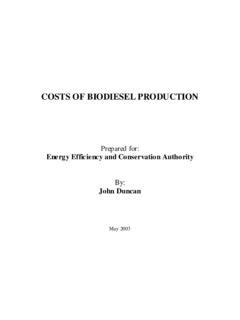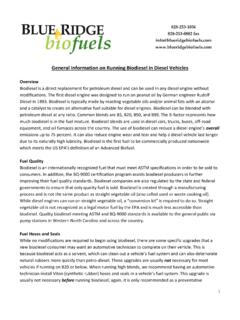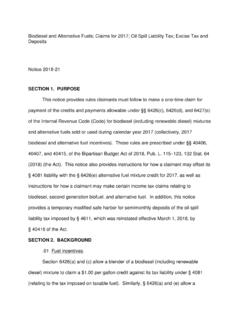Transcription of Palm fatty acid distillate biodiesel - LIPOCHEM
1 May 2010 Cheah, , and KohTwo years ago we looked at the challenges faced by the biodiesel industry (Building plants for bio-diesel and co-products, inform 19:302 305, 2008) and also examined the co-products that could improve the economic viability of the industry. In the interval, the situation for the biodiesel indus-try has not improved, with the high cost of feed-stocks continuing to be the bane of biodiesel producers. The promise of alternative low-cost non-food feedstocks such as jatropha has yet to materialize, and there seems to be, at the current moment, no light at the end of the tunnel in the search for low-cost feedstock alternatives.
2 Most biodiesel plants use the conventional sodium hydrox-ide/sodium methoxide-based transesterification process, which requires highly priced refined oil feedstock. Although palm oil is one of the more competitive feedstocks for biodiesel produc-tion, it can be expensive because its price is linked to that of crude petroleum (Fry, 2010). However, during the refining of palm oil, a lower-value by-product known as palm fatty acid distillate (PFAD) is generated in the fatty acid stripping and deodorization stages. PFAD is potentially a valuable, low-cost feedstock for the pro-duction of biodiesel . It also makes the much-debated food vs. fuel argument a non-issue as PFAD is generally sold as a source Palm fatty acid distillate biodiesel : A palm fatty acid distillate (PFAD) biodiesel plant as viewed from the control 10 2644/30/10 12:29:54 PMMay 2010 inform265 Biofuelsof industrial fatty acids for non-food applications.
3 It has also been used as a fuel in power plants and industrial and Indonesia are the largest producers of palm oil. In 2009, Malaysia and Indonesia produced about and million metric tons of crude palm oil, respectively (Mielke, 2010). In Malaysia, most of the crude palm oil is refined locally for export to overseas markets, mainly for food applications. Almost 700,000 metric tons (MT) of PFAD were produced in Malaysia as a by-product of the refining process (MPOB, 2010). PFAD The Low-CosT FeeDsToCk For BIoDIeseLThe amount of readily available PFAD is not insignificant, and it presents biodiesel producers with excellent access to a low-cost, non-food source of feedstock.
4 PFAD is always traded at a discount to crude or refined, bleached, and deodorized (RBD) palm oil (Fig. 1). Before October 2009, the discount typically exceeded $200/MT, and it was as high as $680/MT in May 2008. However, since November 2009, the price differential between PFAD and RBD palm oil has narrowed. In early 2010 the discount of PFAD over RBD palm oil was less than $100 per ton (Fig. 2). PFAD biodiesel PLAnTsAlthough the basic process for the conversion of high- acid oil feedstock to biodiesel is well known, it has been carried out mainly in small-scale batch-type processes. A breakthrough came in October 2009 with the successful operation of the world s first continuous large-scale 200 MT/day PFAD biodiesel plant (in Sumatra, Indonesia).
5 In this plant, owned by a large Asian-based multinational palm oil group, fresh PFAD from the refin-eries is sent directly to the PFAD biodiesel plant for conversion to biodiesel . The benefits of a continuous PFAD biodiesel process include single person control room operations and a fully automated and tightly controlled management of all process parameters for con-sistent biodiesel product quality. The biodiesel yield from this plant approaches 100%, and it fully meets EN (European Stan-dards) specifications. After distillation, the PFAD biodiesel also passes the ASTM Cold Soak Filtration Test, introduced in 2008. Two more PFAD biodiesel plants using the above process technology will be operational in Pasir Gudang, Malaysia, and Kalimantan, Indonesia by May 2010.
6 These plants can also operate using refined oil GenerATIon MuLTIPLe FeeDsToCk BIoDI eseL P LAnTs By incorporating a continuous esterification section, a biodiesel producer with a conventional sodium hydroxide/sodium methox-ide-based transesterification process now has the opportunity to possess a new, truly multiple feedstock plant able to handle differ-ent raw materials including PFAD. By using the above processes, combined with pretreatment and other processes, the variety of feedstock can be further expanded to include low-quality and high free- fatty - acid (FFA) oils, thereby ensuring that a very wide range of low-cost feedstocks are available to the biodiesel processor, thus ensuring the profitability of the palm biodieselFIG.
7 1. FOB price of RBD palm oil and PFAD. Abbreviations: RBD, refined, bleached, deodorized; PFAD, palm fatty acid distillate ; MT, metric ton. Source: Malaysian Palm Oil Board. FIG. 2. Price differential between RBD palm oil and PFAD. For abbreviations, see Figure 1. Source: Malaysian Palm Oil 10 2654/30/10 12:29:55 PMinformation For FurTher reADInG:Fry, J., Is it smooth sailing or choppy waters ahead? Paper presented at the Palm and Lauric Oils Con-ference & Exhibition Price Outlook (POC), Kuala Lumpur, Malaysia, March 8 10, 2010. Mielke, T., The price outlook of palm and lauric oils and impacts from the global vegetable oil markets A fundamental approach, Paper presented at the Palm and Lauric Oils Conference & Exhibition Price Outlook (POC), Kuala Lumpur, Malaysia, March 8 10, 2010.
8 Malaysian Palm Oil Board, 2010. Website: www. , , A study on the utilization of PFAD as a source of squalene, Proceedings of the 2000 National Seminar on Palm Oil Milling, Refining Technology, Quality and Environment, Malaysian Palm Oil Board, Selangor, 2000, pp. 146 , , and Y. Mohtar, Characteristics and properties of fatty acid distillates from palm oil, Oil Palm Bulletin 59:5 11 (2009).May 2010 inform266 PhyToCheMICALs FroM PFADPFAD also provides a source of value-added co-products for the biodiesel producer. PFAD contains FFA, with a small amount of unsaponifiable components (1 ) and the remain-der neutral oil. The general characteristics of Malaysian PFAD are shown in Table 1.
9 Modern palm oil refineries consistently produce PFAD with FFA content higher than 88%, and crude palm oil also contains non-glyceride minor components that have been associ-ated with health benefits, some of which are distilled off together with the FFA as unsaponifiable components. The unsaponifiable materials of PFAD have long been con-sidered a potential source of highly valuable phytochemicals (Gapor, 2000). Vitamin E, phytosterols, and squalene are of par-ticular interest, and their beneficial effects are well documented. In fact, tocotrienol from PFAD is being produced commercially. The vitamin E profile of Malaysian PFAD is wt% -tocopherol, wt% -tocotrienol, wt% -tocotrienol, and wt% -tocotrienol (Bonnie and Mohtar, 2009).
10 Depending on the feed-stock and processing conditions, some samples of PFAD can have as much as vitamin E, phytosterols, and squalene. These high-value co-products further improve the profitability of PFAD biodiesel plants. The initial step in the extraction of phytochemicals from PFAD is conversion of the fatty acids into a methyl ester, that is, biodiesel . The methyl ester is then distilled in a short-path evapo-rator where the phytochemicals are concentrated in the residues. The residues are further processed to produce the high-value-added phytochemicals. The distilled methyl ester is a high-quality biodiesel that will meet all biodiesel EN and ASTM specifications, including the Cold Soak Filtration Test.
